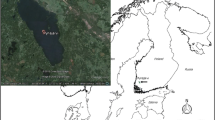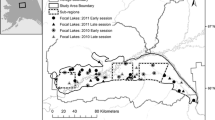Abstract
Lake Ringsjön has been subject to a severe eutrophication process followed by various counter measures, such as nutrient reduction and fish manipulation. We have quantified staging waterfowl populations from 1968, before the eutrophication process reached its maximum, to 1996 when both the nutrient and fish reduction programmes were performed. The general pattern is that high numbers staged in Lake Ringsjön in 1968–1972. In the following 15 years, few waterfowl used the lake as staging area, but from about 1989, the number of birds again began to increase. The likely explanation of this pattern is an improved food availability within the lake, rather than large-scale, national, increases in bird population sizes, a notion strengthened by comparisons with standardized national waterfowl counts. We conclude that there are strong relations between limnological conditions and waterfowl abundances, and that the measures undertaken in Lake Ringsjön improved the lake as a staging area for waterfowl.
Similar content being viewed by others
References
Andersson, G., 1981. Influence of fish on waterfowl in lakes. Anser 20: 21–34 (In Swedish with English summary).
Bergman, E., 1999. Changes in nutrient load and lake water chemistry in Lake Ringsjön, southern Sweden, from 1966 to 1996. Hydrobiologia 404: 9–18.
Blindow, I., G. Andersson, A. Hargeby & S. Johansson, 1993. Longterm pattern of alternative stable states in two shallow eutrophic lakes. Freshwat. Biol. 30: 159–167.
Cronberg, G., 1999. Qualitative and quantitative investigations of phytoplankton in Lake Ringsjön, Scania Sweden. Hydrobiologia 404: 27–40.
Hamrin, S. F., 1999. Planning and execution of the fish reduction in Lake Ringsjön. Hydrobiologia 404: 59–63.
Hanson, M. A. & M. G. Butler, 1994. Responses of food web manipulation in a shallow waterfowl lake. Hydrobiologia 279/280: 457–466.
Hansson, L.-A., M. Enell & E. Bergman, 1999. Lake Ringsjön: its catchment area, its history and its importance. Hydrobiologia 404: 1–7.
Hargeby, A., 1990. Macrophyte associated invertebrates and the effect of habitat permanence. Oikos 57: 338–346.
Hartmann, J., 1977. Fischereiliche Veränderungen in kulturbedingt eutrophierenden Seen. Schweiz. Z. Hydrol. 39: 243–254.
Lauridsen, T. L., E. Jeppesen & F. Østergaard–Andersen, 1993. Colonization of submerged macrophytes in shallow fish manipu51 lated Lake Væng: impact of sediment composition and waterfowl grazing. Aquat. Bot. 46: 1–15.
Mitchell, S. F. & M. R. Perrow, 1998. Interactions between grazing birds and macrophytes. In E. Jeppesen, Ma. Søndergaard, Mo. Søndergaard & K. Christoffersen (eds), The Structuring Role of Submerged Macrophytes in Lakes. Springer–Verlag, New York.
Nilsson, L., 1972. Local distribution, food choice and food consumption of diving ducks on a south Swedish lake. Oikos 23: 82–91.
Nilsson, L., 1974. Resting and wintering waterfowl on Lake Ringsjön 1968 – 1974. Anser 13: 201–210 (In Swedish with English summary).
Nilsson, L., 1976. Monthly counts as a measure of population changes in some species of Anatidae in South Sweden. Ornis Scandinavica 7: 193–205.
Nilsson, L., 1978. Individräkning av rastande och övervintrande sjöfågel. In Statens Naturvårdsverk Biologiska Inventeringsnormer Fåglar. Stockholm (In Swedish).
Nilsson, L., 1997a. Changes in numbers and habitat utilization of wintering whooper swans (Cygnus cygnus) in Sweden 1964–1997. Ornis Svecica 7: 133–142.
Nilsson, L., 1997b. Internationella sjöfågelräkningarna i Sverige (In Swedish). In SOF 1997. Fågelåret 1996, Stockholm: 41–48.
Persson, L., 1983. Effects of intra-and interspecific competition on dynamics and size structure of a perch Perca fluviatilis and a roach Rutilus rutilus population. Oikos 41: 126–132.
Persson, L., S. Diehl, L. Johansson, G. Andersson & S. F. Hamrin, 1991. Shifts in fish communities along the productivity gradient of temperate lakes – patterns and the importance of size-structured populations. J. Fish. Biol. 38: 281–293.
Scheffer, M., S. H. Hosper, M.-L. Meijer, B. Moss & E. Jeppessen, 1993. Alternative equilibria in shallow lakes. Trends Ecol. Evol. 8: 275–279.
Strand, J., 1999. The development of submerged macrophytes in Lake Ringsjön after biomanipulation. Hydrobiologia 404: 113–121.
Svensson, J., E. Bergman & G. Andersson, 1999. Impact of cyprinid reduction on the benthic macroinvertebrate community and implications for increased nitrogen retention. Hydrobiologia 404: 99–112.
van Eerden, M. R. & B. J. Gregersen, 1995. Long term changes in the northwest European population of Cormorants, Phalacrocrax carbo sinensis. Ardea 83: 61–73
Author information
Authors and Affiliations
Rights and permissions
About this article
Cite this article
Andersson, G., Nilsson, L. Autumn waterfowl abundance in Lake Ringsjön, 1968–1996. Hydrobiologia 404, 41–51 (1999). https://doi.org/10.1023/A:1003709620993
Issue Date:
DOI: https://doi.org/10.1023/A:1003709620993




